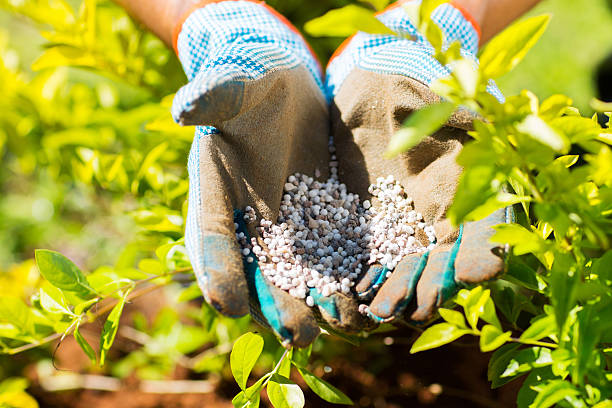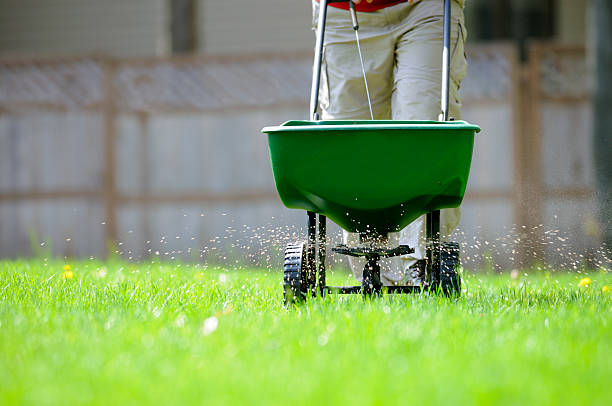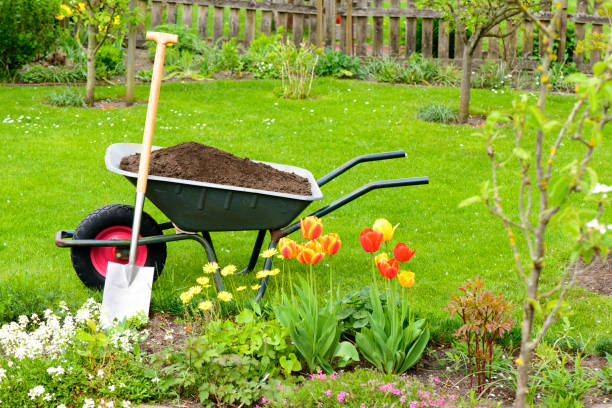The Ultimate Guide To Fertilizing Your Lawn —Everything You Need To Know!
A lush, green lawn serves as a venue for family fun and makes the house you live in look attractive. However, maintaining a well-apportioned lawn takes a lot of effort and time. For a healthy head of grass, you’ve come to a conclusion on feeding nutrients on it. Once you have decided to ensure the health of your lawn, here are some tips to help you get around getting the right tips on fertilizing your lawn.
Table of Contents
Benefits in Fertilizing Lawn
In most cases, the soil can’t supply your lawn with all of the nutrients it needs to thrive throughout the growing season. A lawn that is actively growing consumes a lot of these nutrients. The following are some of the ways lawn fertilizer keeps your grass healthy:
- Assisting with the recovery of foot traffic and pest damage
- It will help decrease the number of weeds in your lawn.
- Replacement of nutrients because of leaching, volatilization, and the removal of grass clippings.
- Fertilizer contains nitrogen, phosphorus, and potassium, three essential nutrients for turfgrass health. Nitrogen makes your lawn green. It also promotes thicker grass and denser shoots. Too much nitrogen can weaken the grass, making it susceptible to leaching, disease, and pest infestation. Phosphorus promotes root growth and growth. Potassium helps grass resist drought, disease, fungus, foot traffic, and extreme weather.
- Fertilized lawns can also promote the growth of a healthy ecosystem of microorganisms, earthworms, praying mantises, ladybugs, and other garden dwellers that prey on pests and unwanted insects.
- As a result of fertilization, the root system of your grass is strengthened, allowing it to absorb more water quickly. Even after a light rain, this helps firm up the soil and reduce the likelihood of muddy puddles forming.

Types of Fertilizer
Slow-release Fertilizer
A slow-release nitrogen fertilizer prevents excess nitrogen from being absorbed by your grassroots. An excessive amount of nitrogen can be detrimental to the health of your lawn.
Fast-release Fertilizer
A fast-release nitrogen fertilizer is often used in combination with a slow-release form. These fertilizers are specifically made to be taken directly into the root zone immediately after application and begin taking effect as soon as they’re applied.
Organic Matter
You’ll need to use many of these materials because the essential nutrients aren’t as concentrated. The best way to get rid of weed seeds in manure is to compost or dry them out before applying them to the lawn.
Liquid Fertilizer
Apply liquid fertilizers after the soil is mowed to remove the first flush of grass. Don’t apply an organic fertilizer to the soil or plants in July and August. Apply fertilizer to the lawn to withstand the harsh winter weather in September and October.
Weed and Feed
The term “weed and feed” refers to lawn care products containing glyphosate and gluconate herbicides. In addition to fertilizing your grass and eliminating weeds like dandelions and clover, it will also kill the weeds in your grass.

Preparation for Lawn Fertilizing
Before you start fertilizing, you should do some preliminary work to ensure that the fertilizer is as effective as possible.
Before Fertilizing
Step 1-Determine your Grass Type
The best lawn fertilizer for a healthy lawn depends on what type of grass you have. Warm-season grasses grow in the southern zones, while cool-season grasses grow in the northern zones. The transitional region is the area in between. You’ll see both warm- and cool-season grasses if you live there. After the first frost, warm-season grasses turn brown, whereas cool-season grasses generally remain green all year. In the warm-season zone, cool-season grasses will not survive the summer. The grass type is:
Warm Seasoned Grass- They include St. Augustine, Bahia, Carpetgrass, Centipede, Bermuda, Zoysia, Buffalo, and other types of grass. During fall, these grasses turn brown after the first fall frost of the year, which makes them look old.
Cool Seasoned Grass- Fine Fescue, Bluegrass, bentgrass, and ryegrass are some of them. Even though cool-season grasses are more cold-tolerant, they still turn a light tan or brown during the coldest winter days in most places.
Step 2- Do a Soil Test
It tells you how alkaline or acidic the soil is, and it helps you figure out what pH your fertilizer should be. At garden stores, you can buy pH testing kits for soil. You can also buy them on the web. Make sure you follow the directions on your kit to figure out the pH of your soil. The best fertilizer for your plants will depend on how acidic or alkaline your soil is.
Take samples from different places and depths, up to 10 to 12 inches (25–30cm). Record all the results for future use.
To learn more about the nutrients in your lawn, take soil samples and send them to a lab for analysis or to your local agriculture extension office.
Step 3- Calculate the Area of Your Grass
Multiplying the length by the width of your lawn will give you an idea of how much fertilizer you need to apply to the desired area. Then subtract the square footage of your house, driveway, and other areas that you won’t be fertilizing from the total square footage.
Example:
Lawn: 250 x 250 ft = 62,500 sq ft
Area not included for fertilizing: 5,200 ft
House: 90 x 40 ft = 3,600 sq ft
Driveway: 13 x 50 ft = 650 sq ft
Total: 53,050 sq ft
Most fertilizer comes in bags that cover 5,000 or 15,000 square feet. Other sizes are also available. How many square feet are in each of the 53,050 bags? You’ll need either eleven 5,000-square-foot bags or three 15,000-square-foot bags and two 5,000-square-foot bags.
You should water your lawn a few days before applying it if you’re using granular fertilizer.
Step 4- Choosing a Lawn Fertilizer That Is Suitable for Your Lawn’s Needs
Your soil’s pH and the type of grass you have will help you choose the right fertilizer for your lawn.
Fertilizers are marked with three numbers: nitrogen (N) for leaf growth, phosphorous (P) for roots, flowers, seeds, and fruit, and potassium (K) for stem growth, water movement in the plant, flowering, and fruiting. These nutrients are shown in this order:
If you used a soil testing lab, the report might say that you should look for a fertilizer or soil amendment that has more nutrients in it. If you’re looking for nutrients, you could look for macronutrients like calcium, magnesium, and sulfur. Micronutrients like copper, iron, zinc, boron, and molybdenum could also be found, as well as the three macronutrients are calcium, magnesium, and sulfur (B). Silicon (Si), cobalt (Co), vanadium (V), or other rare mineral catalysts may be needed from time to time by certain plants or soil conditions.
Step 5-Select a Fertilizer Type
Before deciding which fertilizer to use in your garden, conduct some research. If you’re having trouble making a decision, seek assistance at your local garden center. Consider the following factors.
Fertilizer comes in two forms: liquid and granular. Since liquid fertilizers work so quickly, reapply them regularly. It takes longer for granular fertilizers to be fully absorbed into grass than liquid ones.
Fertilizer granules come in two varieties: fast release and slow release. In a growing season, apply slow-release fertilizers only once or twice.
You can either use chemical fertilizer or natural fertilizer. Organic fertilizer is better for the health of your lawn in the long run than weed-killing fertilizer.

Simple Steps to Apply Fertilizer Correctly
Step 1- Obtain the Necessary Tools and Equipment
The equipment you use to fertilize your lawn can impact the results of your fertilization. You may need to purchase or rent equipment to evenly distribute fertilizer throughout your lawn if you have a large lawn.
For larger lawns, a rotary spreader is the best option. A drop spreader is the best option for smaller lawns with areas that require precise fertilization, such as those around flower beds and landscaping.
Step 2- Get Your Spreader Ready
To ensure proper operation, open and close your spreader while empty. Fill the fertilizer spreader with the right fertilizer for the season and your lawn’s needs. To find out how much to take, look at the package. Adjust the spreader to release the fertilizer at the same rate as the bag’s recommended dosage.
Step 3-Apply Fertilizer
First, choose a location in your yard and activate the spreader’s mechanism. While spraying the fertilizer, walk at a normal pace. Maintain a constant speed without stopping, slowing down, speeding up, or turning off the spreader.
Apply the fertilizer to your entire lawn. Make sure you’re not overlapping or skipping any areas. Make sure you don’t apply too much fertilizer. If you aren’t careful, your yard may suffer from chemical burns. When you’re done, clean your spreader. Using a water hose, spray the inside and outside of the spreader.
Never apply fertilizer near wetlands, rivers, streams, lakes, or ponds. We’re attempting to cultivate lawn grasses, not aquatic weeds. High nutrient loads in these water features will result in weed growth and algae blooms. Nobody wants that. Apply fertilizer 6-8 feet away from water.
Step 4-Water Your Lawn
It will help the fertilizer absorb the soil, resulting in immediate benefits for your lawn.
Step 5- Gather Fertilizer Remains
After you’ve finished fertilizing, sweep up and collect any fertilizer residue that has accumulated on hard surfaces such as your driveway, sidewalk, or road. Fertilizers may wash into water features and storm sewers if left on these surfaces for a long time.
How Often Should You Fertilize Your Lawn With Fertilizer?
Do not overdo fertilizing, even though it has many benefits. At least 5-6 times a year. As soon as the grass begins to sprout and begin to grow, you should begin feeding it. However, the frequency should be known by the weather and the type of grass in your area. Feeding cool-season grasses in the spring is an option, but only necessary.
Spring is the best time to fertilize warm-season grasses like Bermuda grass, St. Augustine and zoysia, centipede, and buffalo grass. Fertilizer should be applied every 6-8 weeks, depending on the amount of water your grass receives. Keep an eye on your lawn’s health. Feeding isn’t necessary if the plant appears to be well-nourished. Do something about your lawn if it’s starting to turn yellow or brown.
Feeding New Grass
Increase the phosphorus in your new grass’s feed to help it develop strong roots. Buy a starter fertilizer—other products with other essential lawn nutrients, like iron for deep green color.
Grass seed should be planted and fertilized according to local and regional guidelines. Before planting seed or plugs, use a regular lawn spreader to apply fertilizer. For sod lawns, fertilize after the sod has been laid down.
You are preventing crabgrass or weed and feed fertilizers from being used in a new lawn area for four weeks before planting is a no-no. Once you’ve seeded your lawn, don’t mow it again until the new grass has had a chance to establish itself.
Feeding Established Lawns
Choose a fertilizer program that adapts to your lawn’s changing seasonal needs to keep it looking its best all year long. Follow our simple, four-part lawn fertilizer schedule each year.
Part 1 – Early Spring
Temperatures rise between February and April, and weed seeds germinate. Prevent new weeds while also feeding your lawn.
Part 2- Late Spring
Between April and June, existing weeds bloom. Always read weed & feed labels carefully and follow instructions. Weed & feeds work best when weeds are young.
Part 3- Summer
Existing weeds bloom from April to June. Always follow the directions on weed and feed labels. When weeds are young, weed and feed treatments work best. Always read the label on the product you’re using, and then follow the instructions on the label.
Part 4- Late Summer to Fall
By the end of the long summer, your grass has just finished a period of relative drought. By the beginning of September, your lawn is suffering. Adding a shot of nitrogen-based fertilizer to your lawn now will help it grow faster before the fall.
